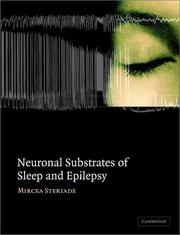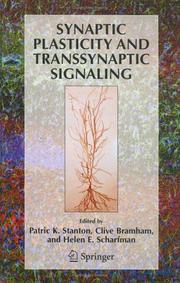| Listing 1 - 10 of 35 | << page >> |
Sort by
|
Periodical
Abstract | Keywords | Export | Availability | Bookmark
 Loading...
Loading...Choose an application
- Reference Manager
- EndNote
- RefWorks (Direct export to RefWorks)
Neural networks (Computer science) --- Neural circuitry --- Artificial intelligence --- Circuitry, Neural --- Circuits, Neural --- Nerve net --- Nerve network --- Neural circuits --- Neurocircuitry --- Neuronal circuitry --- Electrophysiology --- Nervous system --- Neural networks (Neurobiology) --- Reflexes

ISBN: 1107134773 1280159766 9786610159765 0511120885 051104268X 0511148887 0511306083 0511541716 0511054432 9780511042683 9780521817073 0521817072 9780511054433 9780511120886 9780511541711 9781107134775 9781280159763 6610159769 9780511148880 9780511306082 Year: 2003 Publisher: Cambridge : Cambridge University Press,
Abstract | Keywords | Export | Availability | Bookmark
 Loading...
Loading...Choose an application
- Reference Manager
- EndNote
- RefWorks (Direct export to RefWorks)
Different states of vigilance and various paroxysmal disorders that occur during slow-wave sleep can have the same neural bases. Conventional wisdom holds that sleep is a resting state of the brain, with negligible activity of cortical neurons. Here, the author brings new evidence favoring the idea that during this behavioral state memory traces acquired during waking are consolidated. The author focuses on the coalescence of different sleep rhythms in interacting corticothalamic networks and on three types of paroxysmal disorders, namely spike-wave seizures as in absence epilepsy, Lennox-Gastaut seizures, and temporal-lobe epilepsy. Many physiological correlates of waking and sleep states as well as diverse types of epileptic seizures are also discussed. The book has copious illustrations with examples from in vivo, in vitro and 'in computo' studies, the majority coming from the author's own laboratory. Neuronal Substrates of Sleep and Epilepsy is essential reading for neuroscientists and clinical researchers.
Sleep --- Convulsions. --- Neurons. --- Neural circuitry. --- Circuitry, Neural --- Circuits, Neural --- Nerve net --- Nerve network --- Neural circuits --- Neurocircuitry --- Neuronal circuitry --- Electrophysiology --- Nervous system --- Neural networks (Neurobiology) --- Reflexes --- Nerve cells --- Neurocytes --- Cells --- Convulsive disorders --- Convulsive seizures --- Seizures, Convulsive --- Epilepsy --- Spasms --- Physiological aspects. --- Diseases

ISBN: 1280760923 9786610760923 0198026463 9780198026464 9780195105049 0195105044 9780195105056 0195105052 0195105044 0195105052 9781280760921 6610760926 9780195388503 019538850X 9780195388497 Year: 2003 Publisher: Oxford ; New York : Oxford University Press,
Abstract | Keywords | Export | Availability | Bookmark
 Loading...
Loading...Choose an application
- Reference Manager
- EndNote
- RefWorks (Direct export to RefWorks)
This work surveys 2500 years of scientific thinking about the brain from the perspective of fundamental architectural principles. It proposes a model for the basic plan of neural systems organization based on an explosion of structural data from the neuroanatomy revolution of the 1970's.
Brain. --- Neural circuitry. --- Neuroanatomy. --- Nerves --- Nervous system --- Anatomy --- Neurobiology --- Circuitry, Neural --- Circuits, Neural --- Nerve net --- Nerve network --- Neural circuits --- Neurocircuitry --- Neuronal circuitry --- Electrophysiology --- Neural networks (Neurobiology) --- Reflexes --- Cerebrum --- Mind --- Central nervous system --- Head
Book
ISBN: 9780128234549 0128234547 9780128234532 0128234539 Year: 2023 Publisher: London, England : Academic Press,
Abstract | Keywords | Export | Availability | Bookmark
 Loading...
Loading...Choose an application
- Reference Manager
- EndNote
- RefWorks (Direct export to RefWorks)
Neurocircuitry of Addiction focuses on common neural circuits that underly the effects of addictive substances, providing a more holistic view of how these agents produce their effects. This book is organized by brain circuits and their role in addiction, including ventral tegmental area (VTA) circuits, striatal circuits, prefrontal cortical (PFC) circuits, extended amygdala circuits, neuroendocrine circuits, and circadian circuits. It includes a foreword by renowned experts Dr. George Koob (Director of the National Institute of Alcohol Abuse and Alcoholism ) and Dr. Nora Volkow (the Director of the National Institute of Drug Abuse).According to the Substance Abuse and Mental Health Services of America, approximately, 21 million Americans are addicted to at least one substance, and about 20% of Americans who have been diagnosed with depression or anxiety disorder also have substance use disorder.-- People use drugs for many different reasons, including the pursuit of "high," social factors and self-medication of other conditions. Many millions of people are addicted to at least one substance, and the cost of addiction is immense, at both the individual and societal levels. Neurocircuitry of Addiction is the first book of its kind, with a focus on addiction neuroscience from a neural circuit perspective. This book begins with a primer on circuit-based neuroscience that equips the reader with an understanding of the applications described throughout the book. Each subsequent chapter positions a different brain region at the "center" of addiction neurocircuitry and goes on to describe the anatomical connectivity of that brain region, how those circuits are affected by drug exposure, and the role of those circuits in controlling addiction-related behaviors. All chapters of this book are written by content experts for a target audience that has some basic neuroscience background, but no prior in-depth knowledge regarding the neurocircuitry of addiction.
Neural circuitry. --- Circuitry, Neural --- Circuits, Neural --- Nerve net --- Nerve network --- Neural circuits --- Neurocircuitry --- Neuronal circuitry --- Electrophysiology --- Nervous system --- Neural networks (Neurobiology) --- Reflexes --- Substance abuse --- Nerve Net --- Brain --- Substance-Related Disorders --- Physiological aspects. --- drug effects --- physiopathology

ISBN: 1280700874 9786610700875 0387289429 0387289410 1441939636 Year: 2006 Publisher: New York, NY : Springer US : Imprint: Springer,
Abstract | Keywords | Export | Availability | Bookmark
 Loading...
Loading...Choose an application
- Reference Manager
- EndNote
- RefWorks (Direct export to RefWorks)
"The content of the book also serves to emphasize that neuroanatomy is, perhaps more than ever, a thriving and important part of the neurosciences...Most contributions have in common the combination of modern tract-tracing methods with other means of characterizing neural tissue, and thus the book also serves to highlight the gradual disappearance of borders between traditional neuroanatomy and other approaches to the study of the nervous system...this book should continue to be a useful source of information, and deserves to be available in all laboratories applying or considering to apply neuroanatomical methods." P. Brodal, Neuroscience Vol.40, No. 1 .
Neural circuitry --- Neuroanatomy --- Genomics. --- Proteomics. --- Fluorescence microscopy. --- Fluorescent probes. --- Research --- Methodology. --- Molecular probes --- Fluorescence spectroscopy --- Microscopy --- Molecular biology --- Proteins --- Genome research --- Genomes --- Molecular genetics --- Nerves --- Nervous system --- Anatomy --- Neurobiology --- Circuitry, Neural --- Circuits, Neural --- Nerve net --- Nerve network --- Neural circuits --- Neurocircuitry --- Neuronal circuitry --- Electrophysiology --- Neural networks (Neurobiology) --- Reflexes --- Neurosciences. --- Neural sciences --- Neurological sciences --- Neuroscience --- Medical sciences
Book
ISBN: 3319573632 3319573624 Year: 2017 Publisher: Cham : Springer International Publishing : Imprint: Springer,
Abstract | Keywords | Export | Availability | Bookmark
 Loading...
Loading...Choose an application
- Reference Manager
- EndNote
- RefWorks (Direct export to RefWorks)
This book offers representative examples from fly and mouse models to illustrate the ongoing success of the synergistic, state-of-the-art strategy, focusing on the ways it enhances our understanding of sensory processing. The authors focus on sensory systems (vision, olfaction), which are particularly powerful models for probing the development, connectivity, and function of neural circuits, to answer this question: How do individual nerve cells functionally cooperate to guide behavioral responses? Two genetically tractable species, mice and flies, together significantly further our understanding of these processes. Current efforts focus on integrating knowledge gained from three interrelated fields of research: (1) understanding how the fates of different cell types are specified during development, (2) revealing the synaptic connections between identified cell types (“connectomics”) using high-resolution three-dimensional circuit anatomy, and (3) causal testing of how iden tified circuit elements contribute to visual perception and behavior.
Medicine. --- Human genetics. --- Neurosciences. --- Cell biology. --- Biomedicine. --- Human Genetics. --- Cell Biology. --- Neuroanatomy. --- Neural circuitry. --- Circuitry, Neural --- Circuits, Neural --- Nerve net --- Nerve network --- Neural circuits --- Neurocircuitry --- Neuronal circuitry --- Electrophysiology --- Nervous system --- Neural networks (Neurobiology) --- Reflexes --- Nerves --- Anatomy --- Neurobiology --- Cytology. --- Cell biology --- Cellular biology --- Biology --- Cells --- Cytologists --- Genetics --- Heredity, Human --- Human biology --- Physical anthropology --- Neural sciences --- Neurological sciences --- Neuroscience --- Medical sciences

ISBN: 9780521873031 0521873037 9781107411296 9780511541650 051143782X 9780511437823 9780511438493 0511438494 0511541651 1107197872 9781107197879 1281903744 9781281903747 9786611903749 6611903747 0511436378 9780511436376 0511435576 9780511435577 0511437153 9780511437151 1107411297 Year: 2009 Publisher: Cambridge : Cambridge University Press,
Abstract | Keywords | Export | Availability | Bookmark
 Loading...
Loading...Choose an application
- Reference Manager
- EndNote
- RefWorks (Direct export to RefWorks)
Models and concepts of brain function have always been guided and limited by the available techniques and data. This book brings together a multitude of data from different backgrounds. It addresses questions such as: how do different brain areas interact in the process of channelling information? How do neuronal populations encode the information? How are networks formed and separated or associated with other networks? The authors present data at the single cell level both in vitro and in vivo, at the neuronal population level in vivo comparing field potentials (EEGs) in different brain areas, and also present data from spike recordings from identified neuronal populations during the performance of different tasks. Written for academic researchers and graduate students, the book strives to cover the range of single cell activity analysis to the observation of network activity, and finally to brain area activity and cognitive processes of the brain.
Neural networks (Neurobiology) --- Neural circuitry --- Neurons --- Brain --- physiology --- Physiology --- Neural circuitry. --- Circuitry, Neural --- Circuits, Neural --- Nerve net --- Nerve network --- Neural circuits --- Neurocircuitry --- Neuronal circuitry --- Electrophysiology --- Nervous system --- Reflexes --- Biological neural networks --- Nets, Neural (Neurobiology) --- Networks, Neural (Neurobiology) --- Neural nets (Neurobiology) --- Cognitive neuroscience --- Neurobiology --- Neurons - physiology --- Brain - Physiology
Book
ISBN: 0199794693 1299708781 9780199794690 9780199345236 0199345236 9781299708785 9780199794546 0199794545 Year: 2013 Publisher: New York : Oxford University Press,
Abstract | Keywords | Export | Availability | Bookmark
 Loading...
Loading...Choose an application
- Reference Manager
- EndNote
- RefWorks (Direct export to RefWorks)
Here, Chris Eliasmith presents a new approach to understanding the neural implementation of cognition in a way that is centrally driven by biological considerations. According to the semantic pointer hypothesis, higher-level cognitive functions in biological systems are made possible by semantic pointers.
Brain. --- Neural circuitry. --- Neural networks (Neurobiology) --- Cognition. --- Psychology --- Biological neural networks --- Nets, Neural (Neurobiology) --- Networks, Neural (Neurobiology) --- Neural nets (Neurobiology) --- Cognitive neuroscience --- Neurobiology --- Neural circuitry --- Circuitry, Neural --- Circuits, Neural --- Nerve net --- Nerve network --- Neural circuits --- Neurocircuitry --- Neuronal circuitry --- Electrophysiology --- Nervous system --- Reflexes --- Cerebrum --- Mind --- Central nervous system --- Head
Book
ISBN: 9811900302 9811900310 Year: 2022 Publisher: Singapore : Springer Nature Singapore Pte Ltd.,
Abstract | Keywords | Export | Availability | Bookmark
 Loading...
Loading...Choose an application
- Reference Manager
- EndNote
- RefWorks (Direct export to RefWorks)
Neural networks (Neurobiology) --- Neural circuitry. --- Visual pathways. --- Visual system --- Afferent pathways --- Vision --- Circuitry, Neural --- Circuits, Neural --- Nerve net --- Nerve network --- Neural circuits --- Neurocircuitry --- Neuronal circuitry --- Electrophysiology --- Nervous system --- Reflexes --- Biological neural networks --- Nets, Neural (Neurobiology) --- Networks, Neural (Neurobiology) --- Neural nets (Neurobiology) --- Cognitive neuroscience --- Neurobiology --- Neural circuitry

ISBN: 1280613475 9786610613472 0387254439 038724008X 1441936807 Year: 2005 Publisher: New York, NY : Springer US : Imprint: Springer,
Abstract | Keywords | Export | Availability | Bookmark
 Loading...
Loading...Choose an application
- Reference Manager
- EndNote
- RefWorks (Direct export to RefWorks)
Brain functions are realized by the activity of neuronal networks composed of a huge number of neurons. The efficiency of information transfer within the networks is changeable. Even the networks themselves can change through experience. Information transfer between neurons is performed at the synapse (the site of the neurons’ contact) by release of neurotransmitters from the pre-synaptic cell and capture of neurotransmitters by the post-synaptic cell. The amount of released neurotransmitter or the efficacy of capture can change. Moreover, synapses are found to be newly formed upon activity or abandoned upon inactivity. These changes are called "synaptic plasticity". This text focuses on one component of synaptic plasticity called transsynaptic signaling, or communication of synapses during their formation.
Neuroplasticity. --- Neural circuitry. --- Circuitry, Neural --- Circuits, Neural --- Nerve net --- Nerve network --- Neural circuits --- Neurocircuitry --- Neuronal circuitry --- Electrophysiology --- Nervous system --- Neural networks (Neurobiology) --- Reflexes --- Nervous system plasticity --- Neural adaptation --- Neural plasticity --- Neuronal adaptation --- Neuronal plasticity --- Plasticity, Nervous system --- Soft-wired nervous system --- Synaptic plasticity --- Adaptation (Physiology) --- Neurophysiology --- Developmental neurobiology --- Neurosciences. --- Cytology. --- Neurobiology. --- Cell Biology. --- Cell biology --- Cellular biology --- Biology --- Cells --- Cytologists --- Neurosciences --- Neural sciences --- Neurological sciences --- Neuroscience --- Medical sciences --- Cell biology.
| Listing 1 - 10 of 35 | << page >> |
Sort by
|

 Search
Search Feedback
Feedback About
About Help
Help News
News